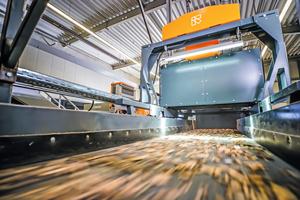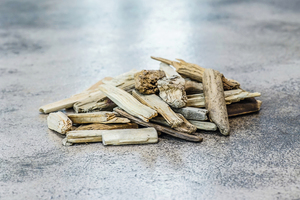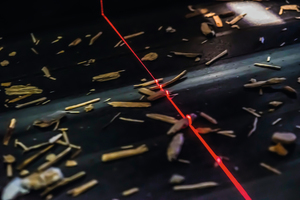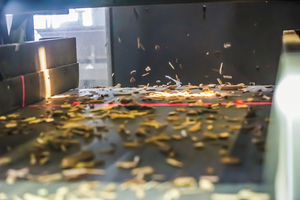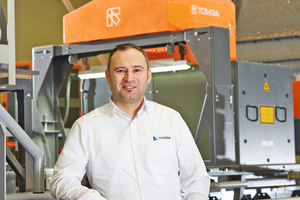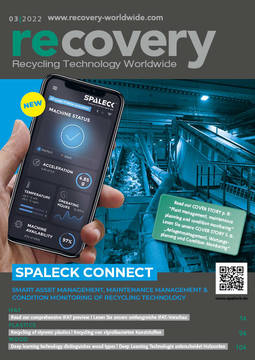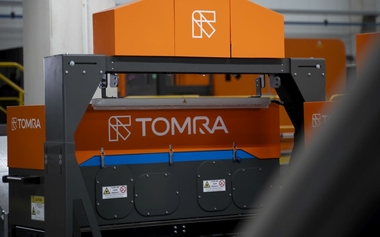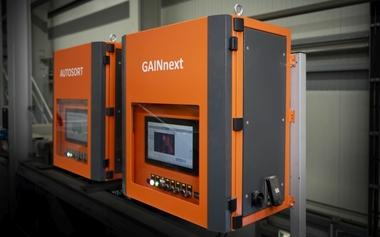Position in the wood recycling segment with a dedicated team is strengthened
As the first sensor-based sorting solutions provider with a dedicated team for the wood segment, TOMRA Recycling sets out to drive the development of waste wood recycling through technology and process improvement consulting for the industry.
Advancing the recycling industry with its state-of-the-art sensor-based sorting technologies and well-established partnerships with manufacturers of wood-based panels, TOMRA again taps into new opportunities by maximizing the use and recycling of waste wood.
TOMRA Recycling has been a frontrunner in the global wood recycling sector for more than 10 years. The company’s X-TRACT solution quickly became popular with chipboard manufacturers to produce a clean recycled woodchip fraction by sorting and separating out the inert material (glass, stones, ceramics, etc.) and metals. Once the X-TRACT unit has removed these impurities, the recovered woodchip is of sufficiently high quality to be used in the production of standard chipboards.
In recent years, however, TOMRA Recycling has been approached by an increasing number of customers who are looking to use recycled wood of a much higher purity level in their production processes. To achieve these specific purity requirements, in addition to removing the inert material and metals in the infeed stream, other impurities including engineered wood composites as well as polymers, would have to be removed.
As these materials are not distinguishable using x-ray technology, the X-TRACT unit was unsuited to this sorting task. Determined to help these customers and recognizing a potential gap in the market for a solution which would allow companies in the wood recycling sector to optimize their wood sorting processes, TOMRA Recycling’s deep learning experts developed an application that combines TOMRA’s industry-leading AUTOSORT® unit with its deep learning-based sorting add-on, GAIN.
After its most recent market launch of a new deep-learning-based sorting application capable of separating wood by type, the company now announces the establishment of an entire team focused on the wood segment. With a newly appointed segment manager, industry-savvy experts, waste wood application specialists, and service key account managers, TOMRA is strategically investing in rapidly enabling the material recycling of waste wood and thus bolstering recycled content for the wood-based panel industry.
New opportunities in waste wood recycling
The primary use of recycled waste wood is currently in particleboard manufacturing. The wood-based panel industry aims to meet very strong market demand and improve product quality by increasing recycled content, resulting in a twofold benefit for the manufacturer. Recycled wood is up to 40 % cheaper than fresh wood and generally dryer, which results in a significant decrease in energy consumption during the drying stage of the panel production.
Jose Matas, Segment Manager Wood at TOMRA Recycling, comments: “The current market development offers a huge opportunity to wood-based panels manufacturers. Using high-quality recycled materials allows them to produce superior quality wood-based panels, achieve higher yields and outputs while profiting from considerable cost reductions, preserving natural resources, and decreasing CO2 emissions.”
Despite the advantages of wood waste recycling and market trends, a lack of infrastructure impedes the sector’s development. Whereas Central Europe performs well in waste management from collection to recycling and reuse, the waste wood market outside Central Europe is still in its infancy. A current view on the market reveals considerable discrepancies in segment maturity and opportunities for growth: Italy, for instance, collects about 2 million metric tons of waste wood annually, of which 63 % is recycled and turned into panel boards. As a result, approximately 2 million tons of CO2 are saved annually, positively impacting the country’s environmental credentials [1]. Opposed to Italy’s high-performing system for waste wood collection and recycling, the European Union and the United States alone leave approximately 100 million tons of waste wood unrecycled [2]. The figures show untapped opportunities that can be exploited when implementing holistic resource systems to effectively collect, sort, and recycle waste wood.
Unleashing the power of sensor-based sorting
The particleboard manufacturer’s quest to increase recycled content and promote sustainable wood management requires optimized processes and advanced technologies to recover pure material fractions from a waste wood infeed stream. Thus, recyclers and particleboard manufacturers are advised to invest in the respective sorting technology to keep pace with industry demands and evolve with the market. New sorting technology quickly adapts to changing waste compositions, increasing purity demands, and recovering single fractions. Integrating a wood sorting solution in recycling and production plants enables them to separate non-processed wood and processed wood from complex mixed waste stream and use the purest materials to produce high-quality particleboard on an industrial scale.
The ideal solution consists of two sorting systems, a high-throughput unit for removing inert material and metals and a state-of-the-art optical sorter with an integrated deep learning technology to separate waste wood into different material grades. Since 2012, TOMRA has been sorting waste wood for high purity clean wood chips. With TOMRA’s X-TRACT, recyclers and particleboard manufacturers can remove impurities like inert materials, metals, and glass with x-ray transmission (XRT) technology and deliver outstanding purity levels for secondary raw materials. A variety of wood-based materials, including engineered wood composites and polymers must be accurately detected and separated into single fractions when creating recycled wood content that meets manufacturing standards. Only wood chip products with the highest quality (Wood A) can replace virgin materials in the production of wood-based panels, hence a new solution had to be found. Always in the pursuit of advancing and optimizing solutions, TOMRA’s in-house team of industry experts, application engineers, and software developers collaborated to develop a new deep-learning-based application to sort wood chips by type. Available as an add-on for the company’s high-performing AUTOSORT®, GAIN is trained to detect, analyze, and separate non-processed wood (Wood A) and processed wood (Wood B).
Valerio Sama, Vice President and Head of Product Management at TOMRA Recycling comments: “Wood recycling is a fast-evolving market, with increasingly stringent legislation being introduced in a number of regions globally to move towards a more circular economy model. Our AUTOSORT® with GAIN solution uses deep learning technology to create a robust and flexible solution which we are confident will be welcomed by wood good producers across to globe. It will also enable our customers to future-proof their operations as they will be better equipped to adapt and react to any future changes in the global wood recycling market such as new legislation. We are delighted to be the first in the market to offer this artificial intelligence-based solution.”
Moreover, it identifies and completely separates the MDF found in processed wood streams, therefore producing individual wood fractions of the highest possible quality for being used in the production of superior quality particleboards and MDF boards. Since TOMRA’s mechanics, sensors, and software are developed in-house, customers profit from perfectly matching machines and a high-performing system enabling them to increase their overall yield and profits.
Fabrizio Radice, Vice President and Head of Global Sales and Marketing at TOMRA Recycling, concludes: “TOMRA is strongly committed to circular waste management. Thus, I am delighted that we extend our focus to the wood segment with a dedicated team that brings a wealth of experience and profound knowledge. The team’s expertise combined with our latest technologies will help recyclers and particleboard manufacturers meet both market demands and exploit the full potential of their operation while minimizing environmental impacts. In the following years, we are going to invest a lot in this promising segment and aim to see that the waste of one company becomes a valuable resource for another – a scenario we support to become commonplace.”
recovery magazine had the opportunity to speak with Murat Sanli, Sales Engineer at TOMRA Recycling, about the new developments in wood recycling and the exciting challenges they present.
recovery: TOMRA has launched its new GAIN sorting system, which uses Deep Learning technologies. This sorting system ha s now been adapted for sorting waste wood. What is the reason for the strong focus on wood recycling?
Murat Sanli: TOMRA has been active in the field of wood recycling for more than 10 years and has been offering solutions for sorting wood chips ever since.
However, in recent years there has been a significant increase in demand from wood-based panel producers who want to increase the recycled content in the production of high quality particleboard and improve their environmental footprint. In order to meet quality and thus purity requirements, waste wood must be freed from impurities and separated into different wood-based material groups (untreated wood, treated wood: particleboard, OSB, MDF/HDF and plywood), because only the purest untreated wood fractions can be used for the production of high-quality particleboard. In order to provide recyclers and the wood-based panel industry with the appropriate tool, TOMRA has added another sorting solution, based on Deep Learning, to its portfolio.
Besides the increased demand, price of „fresh“ wood plays an important role. This is much more expensive than recycled wood and additionally also moister. Moist, fresh wood must first be dried for processing, which is time-consuming and also cost-intensive. Accordingly, wood-based material producers have significant cost advantages when they use recycled wood in production.
Another factor is the limited availability of fresh wood, but this varies from country to country. Recyclers and particleboard producers who process waste wood themselves are thus less dependent on the availability of fresh wood on the market.
Recyclers, for example, also have the flexibility to define which wood material group they want to remove from the waste wood stream and which they want to recover for further processing, thanks to our new deep learning based application. This opens up new markets for the recyclers for the respective wood-based material group.
recovery: What are the current areas of application for this sorting method? Where is the geographical focus as well?
Murat Sanli: TOMRA offers two solutions for sorting waste wood. In the first step, TOMRA‘s X-TRACT is used. This sorts glass, metal and inert materials out of the waste wood stream using X-ray transmission technology and thus according to the atomic density of the object. In a next step, the new solution, a combination of AUTOSORT® and the Deep Learning based add-on GAIN is used to sort the wood by wood material groups. AUTOSORT® plays another important role here, because it is equipped with the necessary technologies to detect and remove polymers from the wood chip stream. Thanks to the latest technologies and deep learning, which is a promising solution for future sorting challenges, processed wood and non-processed wood can be separated and MDF be recovered from the processed wood fraction. The new sorting solution allows plant operators and wood-based panel manufacturers to choose which materials they want to sort within the wood-based panel groups.
The main focus is currently on Europe, although our activities are globally oriented.
recovery: What exactly can be sorted, and what criteria does the Deep Learning technology use?
Murat Sanli: GAIN works based on a neural network and is trained using thousands of images. Based on a pool of object information, it recognizes patterns and properties (e.g. of the wood chips), which it links with the data collected by the sensor and based on which it makes an appropriate sorting decision. The training is based on the images, not on explicit properties or criteria. The neural network can be trained for various sorting tasks and adapted accordingly.
recovery: What is the added value of higher sorting accuracy? Why is it necessary to perform such accurate sorting of waste wood?
Murat Sanli: As in many other recycling applications, the purity of the materials to be recycled plays a decisive role with regard to the desired product quality and thus also in the recycled content of the products to be manufactured (e.g. particleboard). The same principle applies to wood recycling. Accordingly, for the production of high-quality particleboard, not only glass, metal and inert materials must be sorted from the waste wood stream, but also unprocessed and processed wood must be separated from each other. Only the purest fractions of unprocessed wood meet the quality requirements, which are difficult to achieve with conventional technologies.
In addition, the latest technologies allow an increased use of recycled wood also in special chipboards or even in the production of other wood-based materials (e.g. MDF).
With our new solution (AUTOSORT® and GAIN) it is possible to achieve purity levels of 95 % in the separation of processed and unprocessed wood.
recovery: What are TOMRA‘s future plans in the field of wood sorting?
Murat Sanli: Basically, our goal is to support our customers in achieving their goals, to apply our knowledge from decades of experience in a targeted manner, and to develop new applications and enhance existing systems together with customers and partners. We pursue this approach in all segments, including wood recycling.
On the technology side, deep learning technologies, which we see as very promising, will continue to accompany us in the future and the range will be further expanded.

